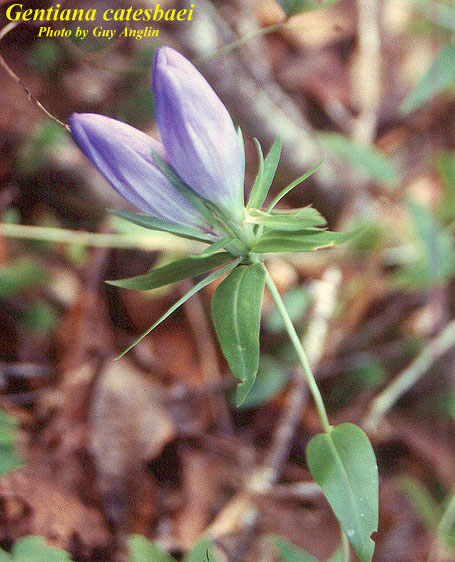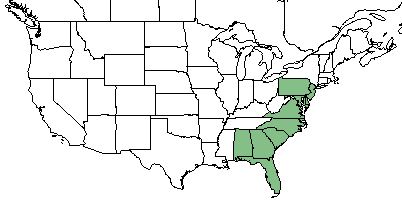Difference between revisions of "Gentiana catesbaei"
Rwagner914 (talk | contribs) (Created page with "{{subst:Template:PlantName}}") |
HaleighJoM (talk | contribs) (→Ecology) |
||
| (25 intermediate revisions by 8 users not shown) | |||
| Line 1: | Line 1: | ||
{{italic title}} | {{italic title}} | ||
| + | Common names: Elliott's gentian; coastal plain gentian | ||
<!-- Get the taxonomy information from the NRCS Plants database --> | <!-- Get the taxonomy information from the NRCS Plants database --> | ||
{{taxobox | {{taxobox | ||
| − | | name = | + | | name = Gentiana catesbaei |
| − | | image = | + | | image = Gentiana_catesbaei_AFP.jpg |
| − | | image_caption = Photo by | + | | image_caption = Photo by the [http://florida.plantatlas.usf.edu/photo.aspx?ID=7558 Atlas of Florida Plants Database] |
| regnum = Plantae | | regnum = Plantae | ||
| divisio = Magnoliophyta - Flowering plants | | divisio = Magnoliophyta - Flowering plants | ||
| − | | classis = | + | | classis = Magnoliopsida - Dicots |
| − | | ordo = | + | | ordo = Gentianales |
| − | | familia = | + | | familia = Gentianaceae |
| − | | genus = '' | + | | genus = ''Gentiana'' |
| − | | species = '''''G. | + | | species = '''''G. catesbaei''''' |
| − | | binomial = '' | + | | binomial = ''Gentiana catesbaei'' |
| − | | binomial_authority = | + | | binomial_authority = Walter |
| − | | range_map = | + | | range_map = GENT_CATES_DIST.JPG |
| − | | range_map_caption = Natural range of '' | + | | range_map_caption = Natural range of ''Gentiana catesbaei'' from USDA NRCS [https://plants.usda.gov/core/profile?symbol=GECA10 Plants Database]. |
}} | }} | ||
==Taxonomic Notes== | ==Taxonomic Notes== | ||
| + | Synonyms: ''Dasystephana latifolia'' (Chapman) Small; ''D. parvifolia'' (Chapman) Small; ''Pneumonanthe catesbaei'' (Walter) F.W. Schmidt.<ref name="weakley">Weakley, A.S. 2015. Flora of the southern and mid-atlantic states. Working Draft of 21 May 2015. University of North Carolina at Chapel Hill, Chapel Hill, North Carolina.</ref> | ||
| + | |||
| + | Varieties: none.<ref name="weakley">Weakley, A.S. 2015. Flora of the southern and mid-atlantic states. Working Draft of 21 May 2015. University of North Carolina at Chapel Hill, Chapel Hill, North Carolina.</ref> | ||
| + | |||
==Description== | ==Description== | ||
<!-- Basic life history facts such as annual/perrenial, monoecious/dioecious, root morphology, seed type, etc. --> | <!-- Basic life history facts such as annual/perrenial, monoecious/dioecious, root morphology, seed type, etc. --> | ||
| + | |||
| + | ''G. catesbaei'' is a perennial forb that is a member of the Gentianaceae family native to the southeast United States.<ref name="USDA"> USDA Plants Database URL: https://plants.usda.gov/core/profile?symbol=GECA10 </ref> | ||
| + | |||
==Distribution== | ==Distribution== | ||
| + | The distribution of ''G. catesbaei'' ranges from north Florida to southeastern Pennsylvania and New Jersey <ref name="USDA"/>. | ||
| + | |||
==Ecology== | ==Ecology== | ||
===Habitat=== <!--Natural communities, human disturbed habitats, topography, hydrology, soils, light, fire regime requirements for removal of competition, etc.--> | ===Habitat=== <!--Natural communities, human disturbed habitats, topography, hydrology, soils, light, fire regime requirements for removal of competition, etc.--> | ||
| − | < | + | ''G. catesbaei'' can be found in "pocosins, moist longleaf pine savanna edges, edges of moist hardwood forests, bluff seepages" <ref name="Weakley"/>. It has been observed in a swale clearing of a wet woodland, in a logged over hillside bog, on the border of a small marsh and a pond, a bottomland woodland, a streamside, floodplain woods, and a ''Magnolia virginiana'' swamp. Habitat typically has saturated, loamy, peat soil.<ref name="Herbarium">Florida State University Robert K. Godfrey Herbarium database. URL: http://herbarium.bio.fsu.edu. Last accessed: May 2018. Collectors: Loran C. Anderson, R. K. Godfrey, A. Gholson Jr., D. C. Vickers, Steve N. Jones, Rodie White, R. Komarek and R. Kral. States and Counties: Alabama: Covington and Coffee. Georgia: Grady and Thomas. Florida: Leon, Gadsden, and Wakulla. </ref> It is listed by the USDA Natural Resources Conservation Service as an obligate wetland species that only occurs in wetland habitats.<ref name= "USDA"/> |
| + | |||
| + | ===Phenology=== <!--Timing off flowering, fruiting, seed dispersal, and environmental triggers. Cite PanFlora website if appropriate: http://www.gilnelson.com/PanFlora/ --> | ||
| + | This species typically flowers from late September through November<ref name="Weakley">Weakley, A. S. (2015). Flora of the Southern and Mid-Atlantic States. Chapel Hill, NC, University of North Carolina Herbarium.</ref>, but can still have flowers present through mid-December.<ref name= "Herbarium"/> It has been observed to flower in November and December as well.<ref>Nelson, G. PanFlora: Plant data for the eastern United States with emphasis on the Southeastern Coastal Plains, Florida, and the Florida Panhandle. www.gilnelson.com/PanFlora/ Accessed: 17 MAY 2019</ref> | ||
<!--===Seed dispersal===--> | <!--===Seed dispersal===--> | ||
<!--===Seed bank and germination===--> | <!--===Seed bank and germination===--> | ||
<!--===Fire ecology===--> <!--Fire tolerance, fire dependence, adaptive fire responses--> | <!--===Fire ecology===--> <!--Fire tolerance, fire dependence, adaptive fire responses--> | ||
<!--===Pollination===--> | <!--===Pollination===--> | ||
| − | <!--=== | + | <!--===Herbivory and toxicology===--> |
| − | <!--==Diseases and parasites==--> | + | <!--===Diseases and parasites===--> |
| − | ==Conservation and | + | ==Conservation, cultivation, and restoration== |
| + | ''Gentiana catesbaei'' is listed as extirpated by the Pennsylvania Department of Conservation and Natural Resources.<ref name= "USDA"/> It is also presumed to be extirpated in New Jersey, and is critically imperiled in Mississippi, as well as vulnerable in North Carolina.<ref>[[http://explorer.natureserve.org]] NatureServe Explorer. Accessed: May 17, 2019</ref> | ||
| − | == | + | ==Cultural use== |
==Photo Gallery== | ==Photo Gallery== | ||
<gallery widths=180px> | <gallery widths=180px> | ||
</gallery> | </gallery> | ||
==References and notes== | ==References and notes== | ||
Latest revision as of 20:09, 30 June 2022
Common names: Elliott's gentian; coastal plain gentian
| Gentiana catesbaei | |
|---|---|

| |
| Photo by the Atlas of Florida Plants Database | |
| Scientific classification | |
| Kingdom: | Plantae |
| Division: | Magnoliophyta - Flowering plants |
| Class: | Magnoliopsida - Dicots |
| Order: | Gentianales |
| Family: | Gentianaceae |
| Genus: | Gentiana |
| Species: | G. catesbaei |
| Binomial name | |
| Gentiana catesbaei Walter | |

| |
| Natural range of Gentiana catesbaei from USDA NRCS Plants Database. | |
Contents
Taxonomic Notes
Synonyms: Dasystephana latifolia (Chapman) Small; D. parvifolia (Chapman) Small; Pneumonanthe catesbaei (Walter) F.W. Schmidt.[1]
Varieties: none.[1]
Description
G. catesbaei is a perennial forb that is a member of the Gentianaceae family native to the southeast United States.[2]
Distribution
The distribution of G. catesbaei ranges from north Florida to southeastern Pennsylvania and New Jersey [2].
Ecology
Habitat
G. catesbaei can be found in "pocosins, moist longleaf pine savanna edges, edges of moist hardwood forests, bluff seepages" [3]. It has been observed in a swale clearing of a wet woodland, in a logged over hillside bog, on the border of a small marsh and a pond, a bottomland woodland, a streamside, floodplain woods, and a Magnolia virginiana swamp. Habitat typically has saturated, loamy, peat soil.[4] It is listed by the USDA Natural Resources Conservation Service as an obligate wetland species that only occurs in wetland habitats.[2]
Phenology
This species typically flowers from late September through November[3], but can still have flowers present through mid-December.[4] It has been observed to flower in November and December as well.[5]
Conservation, cultivation, and restoration
Gentiana catesbaei is listed as extirpated by the Pennsylvania Department of Conservation and Natural Resources.[2] It is also presumed to be extirpated in New Jersey, and is critically imperiled in Mississippi, as well as vulnerable in North Carolina.[6]
Cultural use
Photo Gallery
References and notes
- ↑ 1.0 1.1 Weakley, A.S. 2015. Flora of the southern and mid-atlantic states. Working Draft of 21 May 2015. University of North Carolina at Chapel Hill, Chapel Hill, North Carolina.
- ↑ 2.0 2.1 2.2 2.3 USDA Plants Database URL: https://plants.usda.gov/core/profile?symbol=GECA10
- ↑ 3.0 3.1 Weakley, A. S. (2015). Flora of the Southern and Mid-Atlantic States. Chapel Hill, NC, University of North Carolina Herbarium.
- ↑ 4.0 4.1 Florida State University Robert K. Godfrey Herbarium database. URL: http://herbarium.bio.fsu.edu. Last accessed: May 2018. Collectors: Loran C. Anderson, R. K. Godfrey, A. Gholson Jr., D. C. Vickers, Steve N. Jones, Rodie White, R. Komarek and R. Kral. States and Counties: Alabama: Covington and Coffee. Georgia: Grady and Thomas. Florida: Leon, Gadsden, and Wakulla.
- ↑ Nelson, G. PanFlora: Plant data for the eastern United States with emphasis on the Southeastern Coastal Plains, Florida, and the Florida Panhandle. www.gilnelson.com/PanFlora/ Accessed: 17 MAY 2019
- ↑ [[1]] NatureServe Explorer. Accessed: May 17, 2019